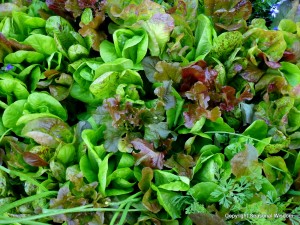
Lettuces are among the gorgeous, cool-season vegetables I’m gathering from our kitchen garden right now. The chilly spring days — and periodic rainstorms — have ushered in many different delicious fresh foods for our homegrown meals. Come take a look at Seasonal Wisdom’s little potager, and see some of my favorite food growing and serving tips at the same time.
Above is ‘Heirloom Cutting Mix’ by Renee’s Garden Seeds. All photos in this post are copyright Seasonal Wisdom.
Around here, we’re reaping the benefits of our gardening work started in early-March. Our raised beds are packed with broccoli, beets, onions, lettuces, radishes and salad greens of all types. This cool-season vegetable harvest is just around the time of our last average frost date here — approximately May 8 — when we start planting warm-season favorites like peppers, corn or beans.
Above is our “work-in-progress” kitchen garden, complete with a small fire pit area for star-lit nights. You can’t see it yet, but there’s a Proven Winners ‘Black Lace’ elder tree planted nearby. In a year or two, it’ll reach a nice size and provide a little shade. Meanwhile, in the far background is a small stone patio we’re building, under the trees, for our new glider.
The kitchen garden has three raised beds with vegetables of all types. Nothing too fancy, but functional and practical enough for us. Other edibles are planted in containers and alongside ornamental plants. So, we always have enough homegrown produce to share with friends and those in need.
In the background, self-seeded orange and pink California poppies run wild among strawberry plants, while a couple of blue and violet-colored clematis start to climb the trellis.
‘Packman’ broccoli is planted in one raised bed, along with edible violas. Once we harvest these center buds, the broccoli plant will send out side shoots with smaller broccoli all growing season. Last time we grew ‘Packman’, it was prolific all summer. I’ve got my fingers crossed it grows that well this year. You can see more photos of this broccoli variety, as well as other warm-season vegetables from my garden, here.
Here’s the 3′ x 3′ raised bed from above. There are four ‘Packman’ broccoli plants, with orange and yellow ‘Sorbet’ violas interspersed among several types of radishes and ‘Paris Market’ carrots. Broccoli and radishes are members of the same family, Brassicaceae, so this will help with my crop rotation for future growing seasons.
The broccoli plants were bought as transplants from my local independent garden center in mid-March. While the plants were small, I sowed seeds for heirloom radishes and carrots around the broccoli. The radishes ripen faster than carrots, and can be harvested in about 30-45 days. Carrots can take about 30 days just to germinate, so they are only starting to appear when you harvest the radishes. More about growing radishes and carrots, along with other cool-season vegetables from seed.
Above is a slower-growing ‘Paris Market’ carrot just popping out of the ground, as a ‘Purple Plum’ radish is ready to be harvested. This compatible growing schedule makes carrots and radishes good neighbors in the garden, especially with broccoli. Using this “interplanting” growing approach, allows me to harvest a lot more vegetables from a small space.
Here are some of the lovely radishes we’ve harvested this week. On the left, ‘Helios’ is a golden heirloom from Slovakia. Next is a richly colored ‘Purple Plum’; a baby ‘French Breakfast’ picked before the white bottom could show; and a round, red ‘Easter Egg.’
These radishes are as delicious as they are photogenic. We chop them fine for crunchy salads. Or, we’ll saute the radishes in olive oil with garlic, herbs, finely cut radish leaves and a couple splashes of salad vinaigrette. Near the end of the cooking process, we’ll add a few cherry tomatoes, cut in half, and a large handful of chopped basil. Plus, a little salt and pepper to taste. Then, serve immediately. The radishes taste surprisingly mild and yummy this way. Try this healthy side dish with some grilled local pasture-raised meat.
Moving down the raised beds, you’ll come next to my raised bed with ‘Candy’ onions (85 days) and ‘Jewel-Toned’ mixed beet greens. In late-March, I sowed seed for three types of beets: ‘Red Sangria’ with ‘Golden Beets’ and candy-red and white-striped ‘Chioggia.’ The Jewel-Toned beets came from Renee’s Garden Seeds, and take about 55 days to mature. More: See my beautiful beets from this year’s harvest!
In past years, some critters were eating my beet leaves before I could harvest the colorful roots. This time I decided to fight back in eco-friendly ways. I planted onions with the beets, as I heard they made good companion plants and I hoped the Alliums would keep away the beet pests. Then, I used Ross Garden Netting to keep hungry birds from eating up my leaves. As you can see, it’s working quite well without any chemicals.
The last raised bed is filled with ‘Heirloom Cutting Mix’ salad greens from Renee’s Garden Seeds, along with some ‘Candy’ onions and edible violas. I sowed lettuce seeds all over the raised bed in mid-March, after I had amended the soil with well-aged manure. (This soil preparation was done to all the raised beds, and watered well. As a farmer once told me, “Feed the soil, and the soil will feed you.)
Lettuces like rich, moist soil with good drainage. These heirloom salad greens are “cut and come again” types, so we clip away the biggest leaves down at the ground level, and the plants produce new ones. I’m sure you can imagine how colorful our salads have been in recent weeks. We’re eager to enjoy these tasty lettuces as long as possible, before the summer sun makes the tender leaves bolt and turn bitter.
Even if you have a small-spaced garden, you can still grow lettuce and salad greens. This plastic planter was sowed with ‘Sea of Red’ lettuce that maintains its bright red color even in sun. Three self-seeded green lettuces were replanted here. The white container sits alongside a sunny spot near the pretty herb Feverfew. Learn more about growing lettuce.
Before long we’ll be harvesting these cool-season plants, and looking towards hot summer. Our garden beds will be replaced with beans, tomatoes, peppers and other warm-season vegetables. The onions and broccoli plants will stay, however, until ready to harvest.
Meanwhile, what’s growing in your garden right now? Do these vegetables grow well in your growing areas? What cool-season vegetables are on your “must-grow” lists?
Learn more. Growing peas, carrots and salad greens. Growing greens, radishes, tomatoes, peppers and eggplants.
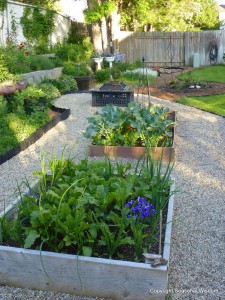
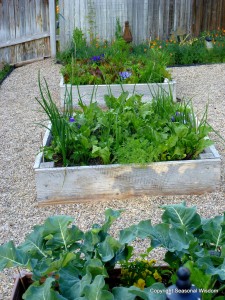
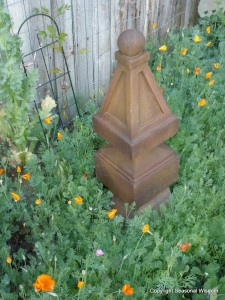
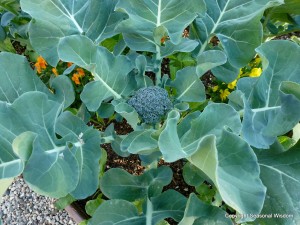
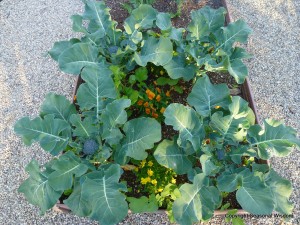
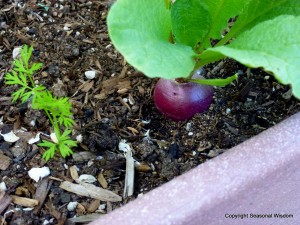
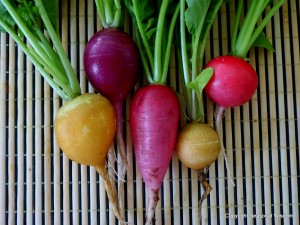
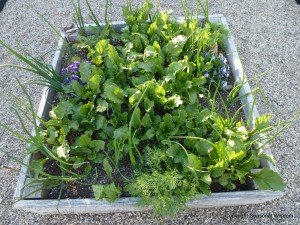
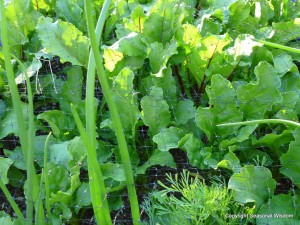
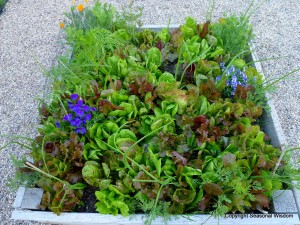
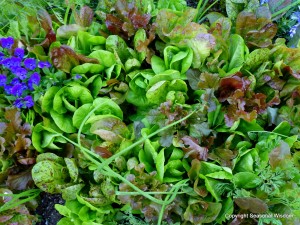
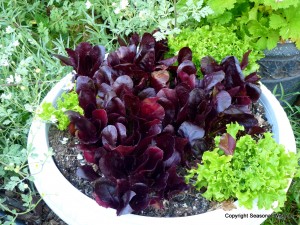











{ 7 comments }
Such pretty veggie beds! Your garden is looking very lush!
Thanks so much, Victoria. Almost time to plant the warm-season vegetables around here. Warm regards, Teresa
Your veggie garden looks absolute fresh and wonderful. I am a little farther behind. I sewed my cool weather seeds around Easter. I am currently harvesting crisp fresh lettuce (all varieties) and muti-colored radishes. My goal is to work on rebuilding my soil. I built new raised beds this year. I am very disappointed in the local veggie soil mix I purchased. It’s very sandy. My plan is to add compost and a ton of mulch when my seedling are a bit taller.
Janell: You sound like you’re off to a great start! Good for you for focusing on building healthy soil. As you know, everything grows better that way. And thanks for your nice comments about the garden. They are very appreciated and make the hard work worthwhile. Have a great harvest this year. Teresa
I just stumbled upon your website while looking for more information about Pattison Golden Marbre Scallop squash. I am so excited about this variety that can provide both summer AND winter squash!!
I love your beautiful photos and bits of gardening wisdom. This year I also interspersed onions with many of my other veggies and it does seem to help with deterring pests.
I am also happy to see that you like to use your space wisely and you’re not afraid to fill it! I like looking out into my backyard and seeing my beds full and lush looking, even this early in the season!
Wonderful website! Keep sharing your insight and experience!!
Hi Peggy: Thanks so much for your message. I felt the same excitement when I discovered Pattison Golden Marbre Scallop squash. With my suburban garden, I’m always looking for ways to grow lots of flowers and food in small spaces.
Thanks for sharing your companion planting tips about onions. Alliums do deter pests. But I’ve heard they aren’t good near peas and beans, however. Appreciate your stopping by and saying hello. Hope to see you again! Teresa
While it’s not a complete science, companion planting techniques can be helpful at keeping away pests and diseases. More information from The Vegetable Garden – http://www.thevegetablegarden.info/companion-plants
Comments on this entry are closed.
{ 3 trackbacks }